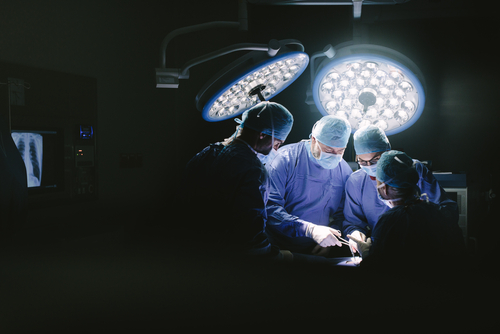Some patients might not think twice about where a doctor operates, be it in an en suite operating room or a local hospital. Patients have enough on their minds, like the anxiety of having an elective procedure, the costs, recovery, and results, which can weigh heavily on them. But truth be told, where surgery is performed plays a more important factor than most patients realize. When your surgeon is comfortable, and at ease in the space where they are performing surgery, it makes for a more enjoyable experience. Plus, with an in-office operating suite, there are fewer delays, more reliable scheduling, on-site lab testing, enhanced safety features, quality control, an adequately sterilized environment, and no chance of being ‘bumped’ for an emergency case. All in all, it just makes the surgical process that much easier for everyone.
 For years, plastic surgeons have reaped the benefits of in-office operating rooms. Sure, there’s the convenience factor and fewer or no trips to the hospital for surgeries, but the real value in an outpatient setting is the efficacy and safety of these highly coveted and personalized spaces. Unlike a hospital setting, which doesn’t have to suit one person’s needs, an office-based operating room allows for privacy and a better experience—for both the patient and surgeon—from start to finish.
For years, plastic surgeons have reaped the benefits of in-office operating rooms. Sure, there’s the convenience factor and fewer or no trips to the hospital for surgeries, but the real value in an outpatient setting is the efficacy and safety of these highly coveted and personalized spaces. Unlike a hospital setting, which doesn’t have to suit one person’s needs, an office-based operating room allows for privacy and a better experience—for both the patient and surgeon—from start to finish.
Office-based Operating Rooms
The idea of office-based operating rooms was first popular back in the 1960s; they have continued to evolve and expand. Today, most plastic surgeons have one. These elevated spaces range from small sterile rooms to fancy, 1,000-square-foot-plus private settings bedecked with state-of-the-art specialty lighting, pressure-controlled heating and air conditioning systems, high-definition theater-quality monitors and sound systems, and even perfectly designed cabinets and storage for easy access. But beyond the bells and whistles of an office-based operating room, there’s data that suggests better surgical outcomes when surgeons work with the same staff, which is often the case with these spaces.
Since plastic surgeons take great pride in their operating rooms, we thought it was only fitting to speak with three for their insight about why they love their operating room and what makes theirs unique.
Dr. Steven Carp
 Location: Green and Beachwood, OH
Location: Green and Beachwood, OH
Age of operating room: 2 years old
Size: 260 square feet
Most unique feature: Dr. Carp says his operating room is the only facility with an office-based cosmetic surgical suite in the surrounding two counties. “This gives a competitive advantage.”
Music on tap: All genres, mainly from Alexa
Favorite part of the operating room: “I built my operating suite by remodeling the old medical spa in the building and taking over half the space. There, I can be in full control from start to finish of patient care. I have the equipment that I need, and it is in working order. I am considering expanding to add possibly a second operating room.”
Dr. Jonathan Kaplan
Location: San Francisco 
Age of operating room: 2013
Size: 20 x 18 feet
Most unique feature: “It’s set up for an overhead GoPro bird’s eye view to record the operation, of course with the patient’s permission.”
Music on tap: Howard Stern on SiriusXM
Favorite feature of the operating room: “Updating surgical equipment to the latest and greatest instruments, like those for powered-assisted liposuction.”
Favorite part of the operating room: “It’s in my office, so I don’t have to travel. But also the VIP experience and convenience factor for both our patients and staff.”
Dr. Samuel Shatkin
 Location: Amherst, NY
Location: Amherst, NY
Age of operating room: 33 years old (the first operating room was set up in 1989 at the time of the office’s original accreditation with AAAASF)
Size: There are three operating rooms in the office-based surgery center; two are 16 x 16 feet, and the third is 10 x 14 feet
Most unique feature: The two main operating rooms have been fully refurbished with a new HVAC system, which Dr. Shatkin says is the best. “We use the Opragon system, which uses gravity instead of having a laminar flow filtration to reliably control the airflow temperature in our OR. Cooler air above the patient is heavier, and the temperature gradient draws airflow from above down past the operating room table and filters it below the table and back through the HEPA filtration, thus carrying airflow away from the patient and reducing bacteria-containing particles in the entire room. It’s the best in the world and creates a safe surgical experience.”
Music on tap: “I love oldies—they’re always familiar to me and help me focus.”
Favorite part of the operating room: “It’s convenience and safety. There’s quick turnover, and while in-between cases, I can be more efficient with my time. And, of course, my anesthesia and nursing staff.”
What’s next up for the space: “We are constantly adding new technologies, such as laser and non-surgical rejuvenation and hair restoration, that are performed in our operating suite.”
Written by Elise Minton Tabin




